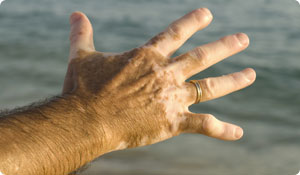
Vitiligo is a condition that causes areas of the skin (or hair) to completely lose pigment and cause lighter patches to appear. It can affect people of any ethnicity, and targets both women and men. In most cases, the condition is painless, though some people with vitiligo complain of itching and pain. Vitiligo can also affect patches of hair on the head or eyelashes.
Types of Vitiligo
The most common type is called non-segmental or generalized vitiligo. It usually begins on the hands, feet, or around the eyes or mouth. Skin color loss occurs in a stop-and-start pattern throughout the person's lifetime. Segmental vitiligo is limited to one part of the body, like an arm, eyelash, or spot of hair.
There are three sub-types of vitiligo.
- Localized vitiligo is when a few patches appear on a single or few areas of the body.
- Generalized vitiligo shows up in patches all over the body.
- Universal vitiligo, which is very rare, presents as a loss of most pigment all over their body.
The Causes of Vitiligo
Vitiligo occurs when melanocytes (cells responsible for pigment) in the skin die, but scientists are not sure why this occurs. They know it can be hereditary and can be linked to auto-immune problems like alopecia areata, pernicious anemia, or Hashimoto's disease. What's more, the different types and sub-types of vitiligo may have different causes.
Diagnosing vitiligo is usually straightforward for dermatologists. They may use a specialized light to examine your skin, and will typically test for thyroid and other auto-immune conditions since they are often linked to vitiligo.
Treatments for Vitiligo?
Since pain is rare for most people with vitiligo, it usually only requires cosmetic treatment, but there are therapies that can help.
- Makeup. For mild cases, cosmetics may be enough to disguise the discoloration.
- Medicine. Prescriptions are available to help re-pigment the skin. Potent corticosteroids are successful in re-pigmenting small parts of the skin about 45 percent of the time.
- Light therapy. Treatment using a light box or excimer laser treatments can be very effective, though most treatments must be continued or you risk relapse.
- Combination therapies. PUVA light therapy combines light therapy and an oral medication called psoralen. This approach requires a lot of therapy and is more effective on some parts of the body than others.
- Surgery. Surgical procedures can also be an option, though they're usually a last resort.
- Supplements. Some people also encourage taking natural herbs like ginkgo boloba, though this herb is not scientifically proven. In rare cases, dermatologists may help to remove pigment from parts of the skin not affected by vitiligo in order to give patients universally light skin.
Craig Kaffert, MD, reviewed this article.
Sources:
Nih.gov. "Vitiligo" U.S. National Library of Medicine. Web. July 11, 2012
http://www.ncbi.nlm.nih.gov/pubmedhealth/PMH0001834/
aad.org "Vitiligo" American Academy of Dermatology. Web. 2013
http://www.aad.org/skin-conditions/dermatology-a-to-z/vitiligo





